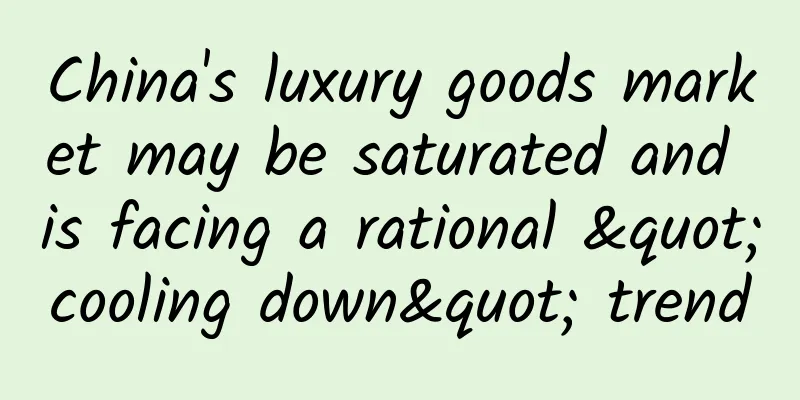China's luxury goods market may be saturated and is facing a rational "cooling down" trend

|
Introduction: Although Chinese consumers are still the world's largest luxury consumer group, with the hot popularity of fast fashion and light luxury, as well as the increasing convenience of overseas shopping, the high-end luxury fever that originally swept China is experiencing a rational "cooling down". In the past year, the growth rate of luxury goods sales in China has dropped to 2%, breaking the double-digit growth inertia that had been maintained for many years. Among them, the sales diversion of super first-tier luxury goods and first-tier luxury goods has attracted the most attention. Last month, Knight Frank, a world-renowned real estate consulting firm, and Woods Bagot, a design consulting firm, jointly surveyed more than 40 high-end retailers and released a report stating that “in 2013, about two-thirds of high-end retailers failed to meet their earlier goals for opening new stores in China.” Greater China's purchasing power for luxury goods once accounted for 29% of the world's total luxury spending, ranking first in the world, 7 percentage points higher than the second-placed United States. But those days are probably gone forever. The "Luxury Industry Outlook Report" jointly launched by the Italian Luxury Industry Association, Boston Consulting Group and BNP Paribas pointed out that from the perspective of the relationship between store penetration and per capita national income, China's luxury market is close to saturation. However, regarding the turning point encountered by international first-tier luxury brands in their development in China, some voices within the retail industry regard this node as an excellent opportunity to "look back" and call for them to "re-develop" rationally. "With the rapid development of China's economy, consumers' mentality has been changing. When they first have money in their pockets, they hope to upgrade their consumption and buy more high-end goods. This process will also be accompanied by some irrational consumption habits. This situation has also occurred in the Japanese market before. For example, in the 1980s, after Italian brands entered the Japanese market, even old ladies in first-tier to third-tier cities in Japan had to wear Italian clothes." Hiroyuki Murai, CEO of Baroque Group, told the 21st Century Business Herald reporter. In Murai Hiroyuki's opinion, under the influence of factors such as China's economic growth gradually stabilizing, the expansion of the middle class, and the olive-shaped trend of income distribution, the proportion of people with high incomes is gradually shrinking. In the process of rational consumption, the middle class prefers light luxury or fast fashion products rather than traditional first-tier luxury goods. The impact on the sales of luxury goods in physical stores comes from all aspects. In addition to factors such as the impact of economic trends, the diversion effect of e-commerce is also very obvious. Yu Yejiali, audit partner of PwC's retail and consumer goods industry, told the 21st Century Business Herald that the sales of luxury goods companies in physical stores are now greatly diluted by third-party e-commerce platforms such as Taobao and Tmall, and some counters are almost only used as physical display cabinets. In this process, retailers need to adjust their organizational structure to adapt to the true integration of online and offline, and optimize the product portfolio. The change in the attractiveness to consumers also affects the change in the voice of these luxury brands in the process of attracting investment in Chinese department stores. "When consumers become more mature and rational and no longer blindly pursue big brands, developers will not be so fanatical about big brands. The agglomeration effect brought by luxury brands is gradually weakening, and international luxury brands are also lowering their assessment of the consumption environment in the Chinese market. Therefore, the preferential treatment that the external environment can provide to luxury goods has also shrunk." said Mi Shizhe, deputy director of investment promotion of China Excellence Outlets Investment Co., Ltd. Luxury goods companies' judgment on market enthusiasm will soon be reflected in changes in the total number of stores in China. According to estimates by Lyon Securities, the adjustment of old stores will further affect the speed of opening new stores, and the future store opening speed may drop from the previous average of 3-4 stores per year to 1-2 stores per year. “Indirect Contribution” Outside China Although the sales of luxury stores and individual stores in China are no longer as strong as they used to be, the purchasing power of Chinese consumers has not completely disappeared. "No market can remain an emerging market forever. It will always reach a mature stage. I believe that as Chinese consumers' wealth and awareness increase, they will rely more on the highest-end brands. Even though the economic growth rate is slowing down now, we are still optimistic in the long run. We have enough confidence in this," Fabrice Weber, president of Asia Pacific at Estee Lauder Group, told a reporter from 21st Century Business Herald. Nowadays, luxury buyers who move between countries all year round have become the focus of competition for brands. The short-term fluctuations in sales in China have made major luxury groups focus on the invisible sales in the outbound market. In fact, the contribution of Chinese consumers to overseas markets and offshore duty-free markets in the past two years has attracted the attention of many large luxury goods companies. They are accelerating the coordination and arrangement of resources to further increase investment in brand marketing in China. For example, luxury skincare brands such as Estee Lauder and L'Oreal, noting the strong consumer demand of Chinese consumers at major departure airports and overseas shopping malls, have stepped up their promotion in these special channels in an effort to retain purchasing power from China. "The sales volume in the travel consumption channel is very impressive. Consumers generally stay in airports for a long time, so it is very important to grasp the market in this area," Bruno Pavlovsky, global brand president of French luxury goods company Chanel, pointed out earlier. Richard Perks, head of the retail industry research department of Mintel, a well-known foreign research institution, also released a set of data: "Take luxury consumption at London Heathrow Airport as an example. In 2013, the average per capita consumption of consumers from China, Brazil, Russia and India at the airport increased by 18%. Chinese passengers only account for 0.7% of the total number of passengers at the airport, but their consumption on luxury goods is far ahead of passengers of other nationalities, accounting for a full quarter." Source: 21st Century Business Herald |
Recommend
What are the effects and functions of Cordyceps powder?
Everyone knows the effects of Cordyceps sinensis,...
It’s too hot! Even the trees are starting to move | Environmental Trumpet
Hello everyone, this is the 15th issue of the Env...
Caries, gingivitis... How to treat these 4 dental problems that make you lose your appetite? You will understand after reading this →
Caries, gingivitis, dental trauma and malocclusio...
AI can tell where your photos were taken
"Hi! Tomorrow is Mother's Day and my mom...
Why do scientists in Antarctica always slap seals? Because it's fake...
Recently, an interesting story about a scientist ...
How to eat licorice
For many Chinese people, they all know that tradi...
Street hotpot is "going viral", beware of "table bombs"! Safety reminder for gas stoves →
A gas stove, an iron pot, a folding table, a few ...
Dai Jifeng | The “Temperature” of Traffic
"The problem of 'Chinese-style roads'...
About 1.5 billion people have hearing loss! Noise-isolating earplugs vs. noise-isolating earmuffs, which one is better and how to choose?
The World Hearing Report released by the World He...
A straightforward boy who loves insects has become a "popular science expert" in 60 years
On December 21, 1823, a boy was born in a poor fa...
Vitamin Bt
With the improvement of living quality and the in...
Wake up to a hardened skin from a hot water bottle? Beware of the "low temperature killer"!
Have you ever relied on the warmth of a hot water...
Is Dendrobium cold in nature?
Many people may not have heard of Dendrobium, but...
“The first bucket of milk tea in autumn”, will it save life or kill you?
Yesterday was the beginning of autumn, and “the f...









